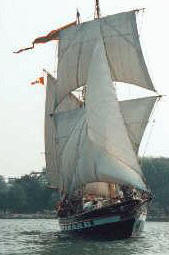
|
_____________
In this section of
____________
Go the section on _____________ Books: American Colonial and
Revolutionary War history or the people involved. We have suggestions
for you. _____________ Copyrighted.
© 2005
to Oct.2009, Leonard H. Bucklin.
-----
The
content of this site may not be reproduced except for brief excerpts for
reviews or scholarly references..
_____________
This is a history education and
research web site of the
|

The history of the Providence provides evidence of connections among Bucklin and other merchants.The photo on the left is of the recreated brigantine St. Lawrence. It gives you the feel of the type of ship we are talking about here. It is the type of ship you see often in the movies as a pirate ship. Before 1775, the naval defense of the American colonists in time of war depended almost entirely upon privateers, fitted out by private enterprise, at the risk of individual owners. The Government, Royal or Colonial, granted letters of "marquee and reprisal" to these adventurers, but was otherwise not responsible for their expenses, their conduct, or their fate. A tenth of the proceeds of a successful expedition was usually returned to the Government which thus became sharer of the profits, though not in the risks of the game. The rest was split up among the owners, captain, and crew. In the employment of such private pirates, the colonies merely followed the example of England. Brigantines were often used as privateers, because of their speed. The brigantine Providence, built at least before 1757 (see below), was the subject of letters marquee, issued by Rhode Island in the Seven Years War which ended in 1763. Do not confuse this privateer brigantine with the several other ships of the same name, existing at much the same time. (E.g., the brigantine Providence was not the sloop Providence commanded by John Paul Jones during the Revolution.) The brigantine Providence of which we speak here was a brigantine, built before any other ships named Providence. The brigantine Providence was commissioned in 1757 by Stephen Hopkins, as governor of Rhode Island, as a privateer to seize goods of France. [Hopkins Esek 491] Esek Hopkins was the captain of the privateer ship. As captain, he sold prize goods in Connecticut, pursuant to a judgment of the Court of Vice Admiralty of Connecticut, in 1757. [Hopkins Esek 491, account of goods sold 1757] In 1757, the first prize taken by the privateer Providence was the ship Desire. The Desire was sold by John Brown, who had been appointed the sales agent. John Brown was 20 years old at the time, and this was his first entry into the merchant business which served him well. In November,1760, Capt Esek Hopkins took his ship Providence to Joseph Bucklin's shop and wharf in Providence where it was repaired with 46 feet of two inch thick keeling wood by Bucklins slave "Prince Bucklin" [Esek Hopkins papers, sloop Elizabeth folder] After the Seven Years War, the brigantine Providence continued in use. In 1768 it was partly owned by Joseph Bucklin the 4th., together with Nicholas Cooke and Benjamin Cushing. Joseph Bucklin served as his own ship's captain at least on some occasions. While carrying rum without taxes paid on the importation, the Providence was seized. In 1768, the Royal Collector of Revenue applied to the Vice-Admiralty Court in Rhode Island to confiscate the ship as being involved in smuggling. Capt. Joseph Bucklin used the flimsiest of factual excuses to defend the case in front of a Rhode Island judge. Joseph won the case, and costs were assessed against the customs collector. Read how this case was typical of Providence merchants using law to defeat customs taxes and harass the tax collectors. As a merchant and as a ship captain and part owner of the brigantine Providence (owned by the partnership combination of Cooke, Cushing and Bucklin) Capt Joseph Bucklin 4th had reason for participating in actions to prevent what Rhode Islanders considered unconstitutional use of force by the English. In 1772, Brown suggested to one of his ship captains that he avoid customs payments by a method being used by Capt. Joseph Bucklin at that time. Later, shortly before the June, 1772, attack on the Gaspee, the brigantine Providence was seized by the English ship Beaver, commanded by Capt. Linzee. Again the charge was evasion of import duties. The record only shows the owner as Benjamin Cushing, but it is possible, even perhaps probable, that the same combination of Cooke, Cushing and Bucklin was still the owners of the ship. If so, Joseph Bucklin 4th would have had just as much an interest in attacking the Gaspee as did the Greenes. Both the Beaver and the Gaspee were making the same sort of inroads on the shipping business of Providence merchants. (The English Navy's plan and hope of effectively patrolling the three entrances from the sea into Narragansett Bay was to have both the Beaver and Gaspee working together.) After the Revolutionary War, the brigantine Providence was purchased and owned by John Brown. John Brown sent the ship out on a voyage to Canton but it did not return. The Providence sustained heavy damage in her voyage and the captain took advantage of the offer of a good price and sold the ship with the cargo together. [Hawes, Off Soundings p. 220]
|


